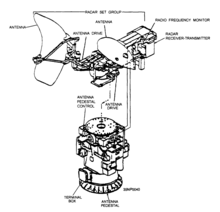 AN/SPN-35 Approach Radar on LPH-2 Iwo Jima, 1987 | |
| Country of origin | United States |
|---|---|
| Manufacturer | ITT-Gilfillan[1](184) |
| Frequency | 9.0 to 9.2 GHz band[2] |
| PRF | 1200[2] |
| Pulsewidth | .2 microseconds[2] |
| Power | 200[2] |
| Related | AN/TPN-8 |
The AN/SPN-35 is a computerized automatic landing system installed on the Tarawa-class amphibious assault ship and other LHA/LHD-class warships to give control for aircraft during the final approach and landing.[3][4]
The Joint precision approach and landing system (JPALS) is slated to replace the AN/SPN-35 on U.S. Navy amphibious assault ships.[5][6]
Description
[edit]The AN/SPN-35 is used to offer guidance to the aircraft pilot on final approach. It provides relative azimuth, range, and elevation information to the radar operator, who relays this as verbal guidance to the aircraft pilot on approach.[7]
The AN/SPN-35A variant has two antennas: the azimuth antenna (AS-1292/TPN-8) and the elevation antenna (AS-1669/SPN-35). The azimuth antenna is located above the azimuth drive assembly on the stabilized yoke. The elevation antenna is mounted on the elevation drive assembly adjacent to the azimuth antenna.[8]

History
[edit]The AN/SPN-35 was developed from the ground-based AN/TPN-8 landing approach control radar.[9](pp171–172)[10] It was first evaluated on the USS Kearsarge in 1962, as an AN/TPN-8 mounted to an AN/SPN-6 stable pedestal and secured to an AN/SPN-8 platform. A prototype was evaluated aboard the USS Bon Homme Richard (CV-31) about a year later as a replacement for the AN/SPN-8 on ASW carriers and small attack carriers.[9](pp171–172) As of 1965, the AN/SPN-35 was being used "primarily on the ASW type carriers."[11]
The -35A variant was used onboard Nimitz-class aircraft carriers prior to 1996, when it was replaced by the AN/SPN-46A/B.[12] It remains in use on the Wasp class and America class today.
Platforms
[edit]
 Royal Australian Navy
Royal Australian Navy
[edit] Spanish Navy
Spanish Navy
[edit] Royal Navy
Royal Navy
[edit] United States Navy
United States Navy
[edit]- Ship classes known to carry this system:
- Tarawa-class amphibious assault ship[3]
- Wasp-class amphibious assault ship[18][19]
- America-class amphibious assault ship[20][21]
- Nimitz-class aircraft carrier - Replaced by AN/SPN-46 in the late 90s.[12]
- Individual ships known to carry this system:
- USS Intrepid (CV-11)[22]
- USS Hornet (CV-12)[9](p27)
- USS Ticonderoga (CV-14) - Installed 1965 while undergoing overhaul at San Francisco Bay Naval Shipyard.[23]
- USS Bon Homme Richard (CV-31) - Initial testing and evaluation
- USS Kearsarge (CV-33) - Initial testing and evaluation
- USS Oriskany (CV-34)[22]
- USS Ranger (CV-61)[24]
- USS Tripoli (LPH-10)[25]
- USS Inchon (MCS-12)[18]
Variants
[edit]- AN/SPN-35: Original model that entered service.
- AN/SPN-35A: Improved stabilization system to compensate for pitch and roll of carrier. Replaces the original mechanical-hydraulic stabilization of the original with an electromechanical stabilization system.[7][9](pp171–172)
- AN/SPN-35B:
- AN/SPN-35C: Upgrade to AN/SPN-35B. Adds Moving Target Detection (MTD), Track While Scan (TWS), and Built-In Test (BIT) capability.[26]
See also
[edit]- AN/SPN-46(V)1
- Joint Electronics Type Designation System – Unclassified designation system for United States military electronic equipment
- List of radars
- List of military electronics of the United States
References
[edit]- ^ a b Moore, John Evelyn (1984). Jane's Fighting Ships 1984-85. Jane's Information Group. ISBN 9780710607959.
- ^ a b c d Maiuzzo, M. Compatibility Factors Affecting Concept Development of Approach and Landing Guidance System (PDF) (Report). IIT Research Institute.
- ^ a b Pike, John (1999). "AN/SPN-35 Aircraft Control Approach Central". Federation of American Scientists.
- ^ Government Accountability Office (March 2010). Defense Acquisitions: Assessments of Selected Weapon Programs (PDF) (Report). p. 81.
- ^ Simmons, Larry D.; Ace III, Floyd L. (1995) [October 1995]. Electronics Technician (PDF). Vol. 7. NAVAL EDUCATION AND TRAINING PROFESSIONAL DEVELOPMENT AND TECHNOLOGY CENTER. pp. 2-29 – 2-30. Retrieved January 12, 2023.
- ^ "AN/TPN-18 - Radartutorial". www.radartutorial.eu. Retrieved November 19, 2022.
- ^ Fuchs, William C (December 1965). "For Unerring Performance of Their Duties". Naval Aviation News: 14.
- ^ a b Elward, Brad (2010). Nimitz-class aircraft carriers. Osprey publishing. p. 29. ISBN 978-1-84603-759-7.
- ^ Thompson, Phil (March 2020). "A4G Pilot Survives Ramp Strike" (PDF). Slipstream. Vol. 31, no. 1. Fleet Air Arm Association of Australia. p. 25. Retrieved January 2, 2023.
- ^ T.C. Lea III; C. P. Senn; J.W. Clark, Jr. (November 1991), "United States Navy Ski Jump Experience and Future Applications" (PDF), AGARD Conference Proceedings 509: Aircraft Ship Operations, AGARD, p. 21-1
- ^ "Principe de Asturias". Naval Technology. Retrieved January 3, 2023.
- ^ Hobbs, David (2013). British Aircraft Carriers: Design, Development and Service Histories. Barnsley, UK: Seaforth Publishing. p. 295. ISBN 978-1-84832-138-0.
- ^ a b HQ TRADOC (1999), Multiservice Procedures for Joint Air Traffic Control (JATC) (PDF), p. E-14
- ^ Gary Warner, PEO Ships Brief to NDIA, p. 27
- ^ Saunders, Stephen; Philpott, Tom (2015). Jane's fighting ships 2015-2016. p. 960. ISBN 978-0-7106-3143-5. OCLC 919022075.
- ^ "Amphibious Assault Ship (General Purpose) Photo Index LHA-6 America". www.navsource.org. Retrieved January 5, 2023.
- ^ a b Stille, Mark (2022). Essex-Class Aircraft Carriers 1945–91. Bloomsbury Publishing. pp. 16–17, 32. ISBN 9781472845795.
- ^ U.S. Navy, Aviation Historical Summary, USS Ticonderoga (CVA-14, 1 Apr 1965-30 Sep 1965 (PDF), p. 5
- ^ Commanding Officer, USS Ranger (CVA-61) (February 23, 1971), USS Ranger (CVA-61) Command History for 1970 (PDF), p. 23
{{citation}}: CS1 maint: numeric names: authors list (link) - ^ Commanding Officer, USS Tripoli. Command History for Calendar year 1972 (PDF) (Report). p. 9.
- ^ U.S. Navy (2001). Navy Training System Plan for the AN/SPN-35C Aircraft Control Approach Central. p. 1.
External links
[edit]- Approach, vol. 9 at the HathiTrust Digital Library - Refer to page 7 of Sept. 1963 issue for discussion of impact for SPN-35 relative to what came before.